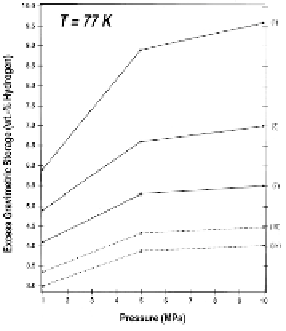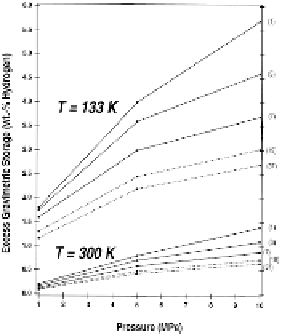Biomedical Engineering Reference
In-Depth Information
Anyway, the approximations made were quite severe so that the
authors themselves have considered their results as qualitative.
The same honeycomb structure of CNT ropes has been used to
perform GCMC simulations [111]. By using the Silvera-Goldman
potential and the LJ potential for the H
interactions,
respectively, it was found that the adsorption isotherms decrease as
the rope diameter increases because the specific area uptake in the
interstitial and endohedral sites is nearly independent on the rope
diameter (see Fig. 8.2).
-H
and the C-H
2
2
2
Figure 8.2
Excess gravimetric storage isotherms at 77 K, 133 K, and
300 K for ropes containing 1-37 CNTs; the number of
constituent tubes per rope is indicated on the right of each
curve. Data connected by solid lines were computed by the
GCMC method discussed in the text; data connected by dotted
lines were derived by scaling the results found for smaller
ropes. Source: Ref. [111].
The reported results are in agreement with recent experiments
and show that the DOE requirements are not satisfied at room
temperature in the 1-10 MPa pressure range, even for isolated
SWCNTs. PIMC simulations for (9,9) and (18,18) SWCNT arrays have
shown that quantum effects can be important even at RT for narrow
adsorption sites. In any case, PIMC results agree with the GCMC
ones (that are slightly overestimated) showing that the previous
optimistic experimental results [21, 28] cannot be explained by
simple physisorption phenomena on pure CNTs [107].




